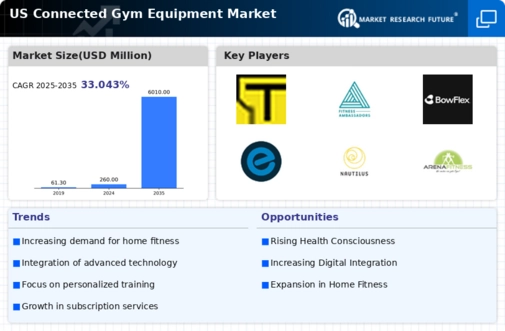Increased Focus on Home Fitness Solutions
The connected gym-equipment market is benefiting from a notable shift towards home fitness solutions. As more consumers prioritize convenience and flexibility, the demand for connected equipment that can be used at home is rising. In 2025, it is estimated that nearly 40% of fitness enthusiasts prefer working out at home, leading to a significant increase in sales of connected gym equipment. This trend is further supported by the proliferation of online fitness classes and virtual training sessions, which enhance the appeal of home workouts. Consequently, manufacturers are adapting their offerings to meet this growing demand, thereby expanding the connected gym-equipment market.
Growing Health Consciousness Among Consumers
is growing due to an increasing health consciousness among consumers.. As awareness of the importance of physical fitness and overall well-being rises, more individuals are investing in connected fitness solutions. Reports indicate that approximately 60% of adults in the US are now actively seeking ways to improve their health, which includes incorporating technology into their fitness routines. This trend is likely to continue, as consumers increasingly recognize the benefits of tracking their fitness progress through connected devices. The market is thus positioned for sustained growth as health awareness drives demand for innovative gym equipment.
Integration of Social Features in Fitness Apps
The connected gym-equipment market is evolving with the integration of social features in fitness applications. These features allow users to connect with friends, share achievements, and participate in challenges, fostering a sense of community. This social aspect is particularly appealing to younger demographics, who are more inclined to engage with fitness technology that offers social interaction. As of 2025, it is projected that around 30% of users will prioritize social connectivity in their fitness choices, influencing their purchasing decisions. Consequently, manufacturers are increasingly incorporating these features into their products, thereby enhancing the attractiveness of the connected gym-equipment market.
Rising Demand for Data-Driven Fitness Insights
The connected gym-equipment market is experiencing a notable rise in demand for data-driven fitness insights. Consumers are increasingly interested in understanding their performance metrics, such as heart rate, calories burned, and workout efficiency. This trend is supported by the growing availability of connected devices that provide real-time feedback and analytics. In 2025, it is anticipated that the market for fitness analytics will grow by approximately 20%, as users seek to optimize their workouts based on data. This demand for actionable insights is prompting manufacturers to enhance their offerings, making the connected gym-equipment market more competitive and innovative.
Technological Advancements in Fitness Equipment
The is surging due to rapid technological advancements.. Innovations such as smart sensors, integrated apps, and real-time data analytics are enhancing user experiences. These technologies allow for personalized workout regimens and performance tracking, which are increasingly appealing to fitness enthusiasts. In 2025, projecting a growth rate of around 15% annually.. This growth is driven by consumer demand for more interactive and engaging fitness solutions. As manufacturers continue to invest in R&D, the connected gym-equipment market is likely to see even more sophisticated features, further attracting a diverse customer base.

















Leave a Comment